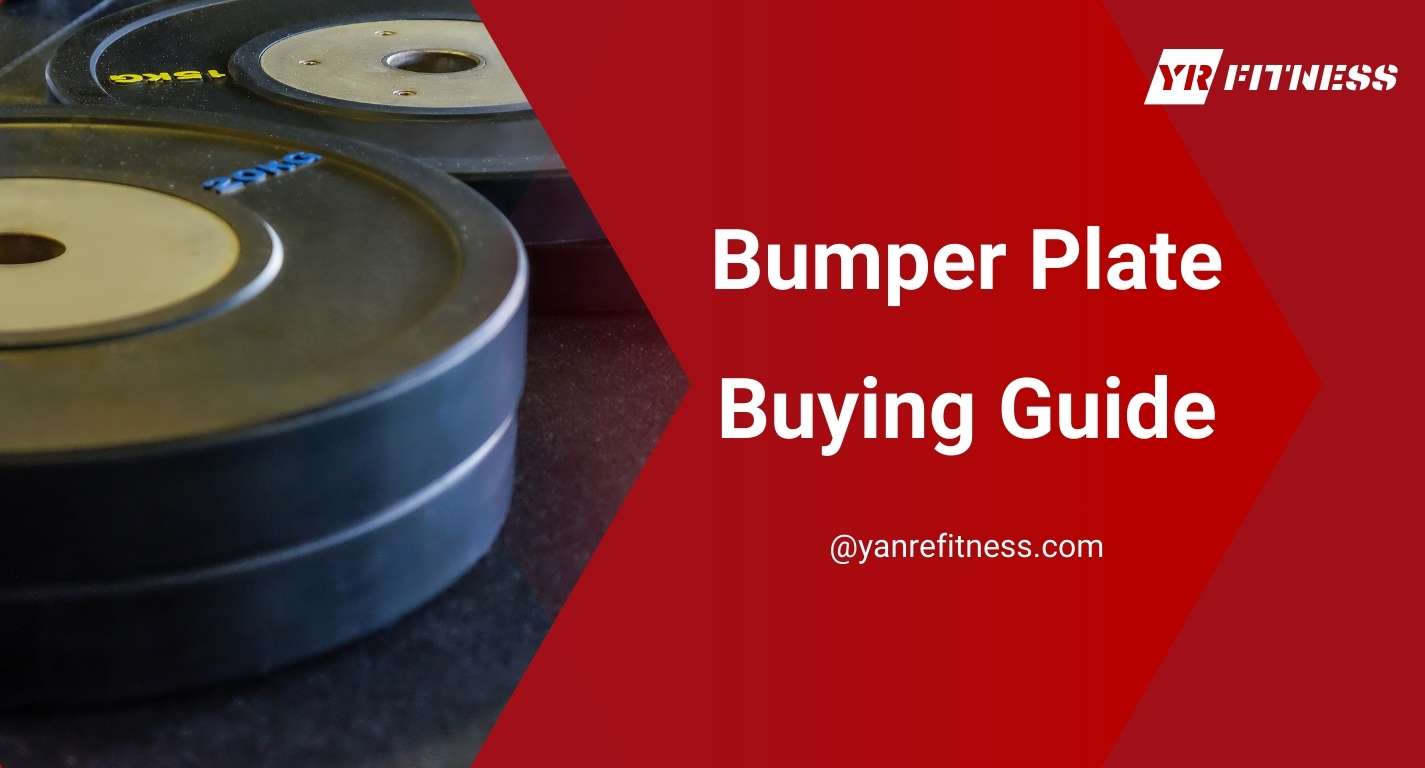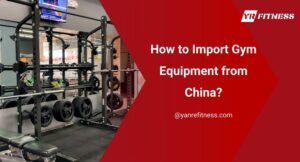Have you been selecting bumper plates for your gym but are unsure which offer the best performance and value? Use our expert guide to find the top options.
With extensive research and interviews with 10 experienced workers from 7 bumper plate factories, this comprehensive resource offers unique insights not found elsewhere.
Bumper plates are crucial for any modern gym, but choosing the right ones requires understanding their differences from weight plates, the ideal types, manufacturing process, and durometer rating.
In this guide, we will cover everything needed to make informed decisions, and we believe it is the most comprehensive guide.
So, let’s dive in!
Table of Contents
1. Bumper Plate Industrial Regions
Bumper plate manufacturing in China is centered in the following regions:
Qingdao: Mainly produces rubber bumper plates, which are often more expensive due to high export volumes. The fact is, this region is known for its large-scale production capacity and reliable export infrastructure.
Nantong: Focuses on urethane bumper plates, with advanced technology and high-quality formulations recognized for their excellence.
Xiamen: Known for high-end bumper plates, the production emphasizes premium materials and precision manufacturing, catering to the high-end market segment.

Choosing the right region impacts your bumper plate quality and cost. YR Fitness partners with top manufacturers for reliable commercial production. Contact our team to discuss sourcing bumper plates that fit your gym’s needs.
2. Bumper Plate Types
Selecting the right bumper plates involves understanding their different types, functions, and materials. Partnering with a trusted commercial gym equipment manufacturer can help ensure you choose bumper plates that deliver the durability and performance your gym requires. Let me explain the key types of bumper plates:
Types by Function
Training Bumper Plate
Bumper plates are weight plates with a constant diameter and varying thickness. Made from dense rubber, they are designed to absorb impacts during weightlifting, protecting the floor, barbell, and plate. Here are the key details about bumper plates:
- Standards: Bumper plates follow IWF guidelines with a consistent diameter and a steel hub to absorb impacts without adding thickness.
- Advancement: Cast-iron plates were once common but were too thick and heavy. Bumper plates were created for Olympic lifting to solve these problems and are now standard in gyms.
- Color and Design: Mostly black but now available in various colors and designs. Some have a metal ring, which makes them thicker and more likely to warp, affecting their weight capacity and cost.
- Compatibility: Made to fit Olympic bars, these plates meet the standards needed for Olympic weightlifting.
Tip:
For IWF or IPF Competitive Weightlifters: Use training bumper plates with precise calibration to maintain technique and performance.
For Non-Competitors: Choose training bumper plates with varied weights and colors to track progress and minimize equipment damage.
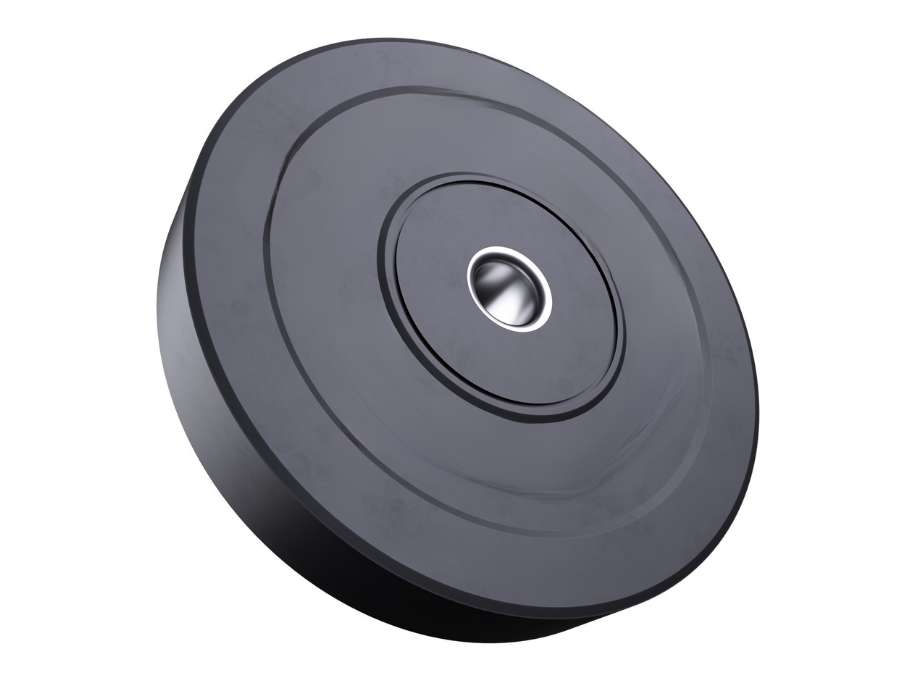
Competition Bumper Plate
Competition bumper plates conform to IWF standards for size, tolerance, and color. These plates are distinguished by their construction and design. Here are the characteristics of competition bumper plates:
- Plate Design: These bumper plates have a solid steel core inside a rubber layer and are about 40% thinner than usual, giving a larger load area on the barbell.
- Construction: Competition bumper plates have a steel hub made of 2 parts bolted together to hold the rubber securely, providing durability.
- Colors and Cost: They come in various colors and are usually more expensive.
- Bounce Characteristics: They typically bounce less than training bumper plates, but this can vary based on the material used.
- Certification vs. Claims: Some plates are claimed to meet IWF standards, but only a few are officially certified. Uncertified plates are called “training plates” and can’t be used in IWF events.
- Increased Costs for Certification: IWF-certified plates cost more due to extra metal and stricter accuracy standards, with a weight tolerance of ±10 grams compared to up to 10% for uncertified plates.
Tip:
- For IWF or IPF Competitive Weightlifters: Consider investing in genuine competition bumper plates for accuracy.
- For Non-Competitors: Avoid spending extra on competition plates, as the cost difference may not offer significant benefits for your workouts.
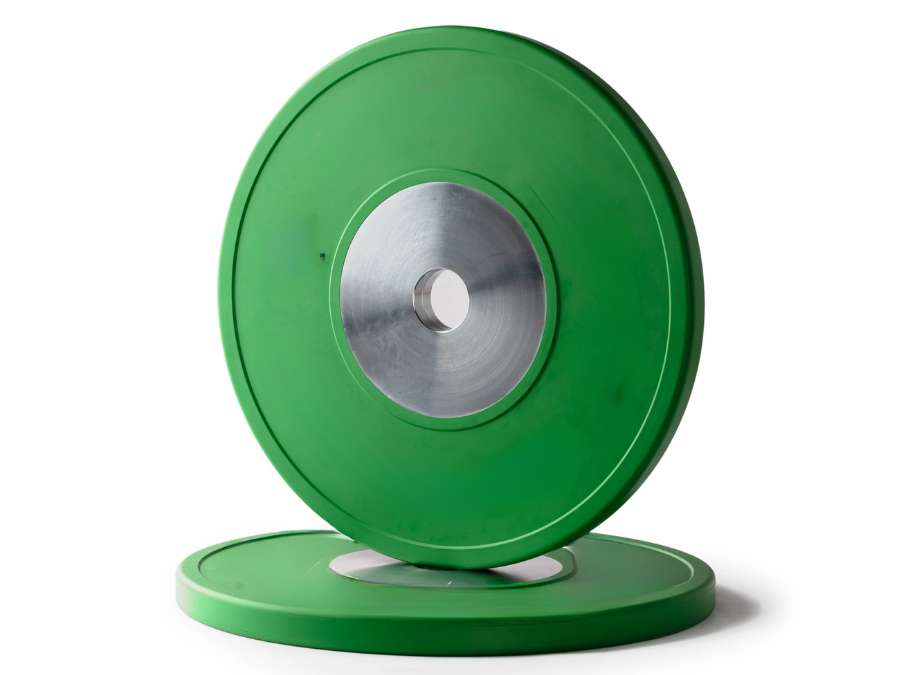
Technique Plates
Technique plates are lightweight, one-piece plastic weights used indoors on rubber floors, perfect for beginners and rehab, and they don’t have a steel hub. Here are the key aspects of technique plates:
- Plate Design: Technique plates are solid, one-piece plastic weights the size of training bumpers, made from polyethylene and designed for indoor use on rubber flooring.
- Application: These light weights help beginners and those in rehab improve their technique by balancing the bar without heavy weight and transitioning to standard bumper plates.
- Weight: Available in 5 lb and 10 lb (2.5 kg, 3.75 kg, and 5 kg) increments. They are costly, but 1 or 2 pairs are usually enough.
- Cost: Technique plates are expensive per pound, but only one or two pairs are needed.
- Materials: Made from a single piece of rubber without a steel hub, they are meant for indoor use on rubber flooring.
Tip:
For IWF or IPF Competitive Weightlifters: Use technique plates to refine form and maintain balance without adding weight.
For Non-Competitors: Use technique plates for form practice and balance during rehabilitation or early training.
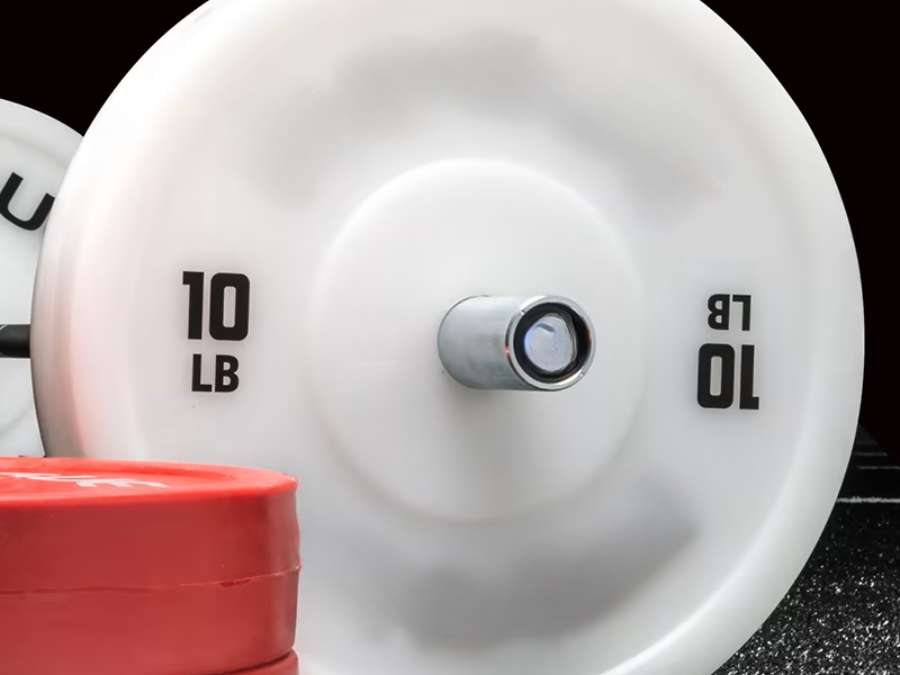
Change Plate
A change plate is a small weight plate with a diameter smaller than standard plates. These plates are used to make precise weight adjustments. Here are the key details about change plates:
- Weights: Change plates are available in weights of 0.5 kg, 1 kg, 1.5 kg, 2 kg, 2.5 kg, and 5 kg for kilograms, and 1.25 lb, 2.5 lb, 5.0 lb, and 10 lb for pounds.
- Sizes: These plates have a smaller diameter compared to standard weight plates, allowing for incremental adjustments without adding significant bulk.
- Purpose: Change plates are used to make small weight increments, which is especially useful when adding standard bumper plates (typically 10 kg or 25 lbs) would be too much.
- Use and Application: They are particularly valuable for weightlifters and bodybuilders who need to make precise adjustments as they progress, providing gradual increases in weight.
Tip:
For IWF or IPF Competitive Weightlifters: Use change plates for precise weight adjustments to achieve exact increments in training.
For Non-Competitors: Use change plates to easily adjust weights for gradual progression and flexibility in workouts.
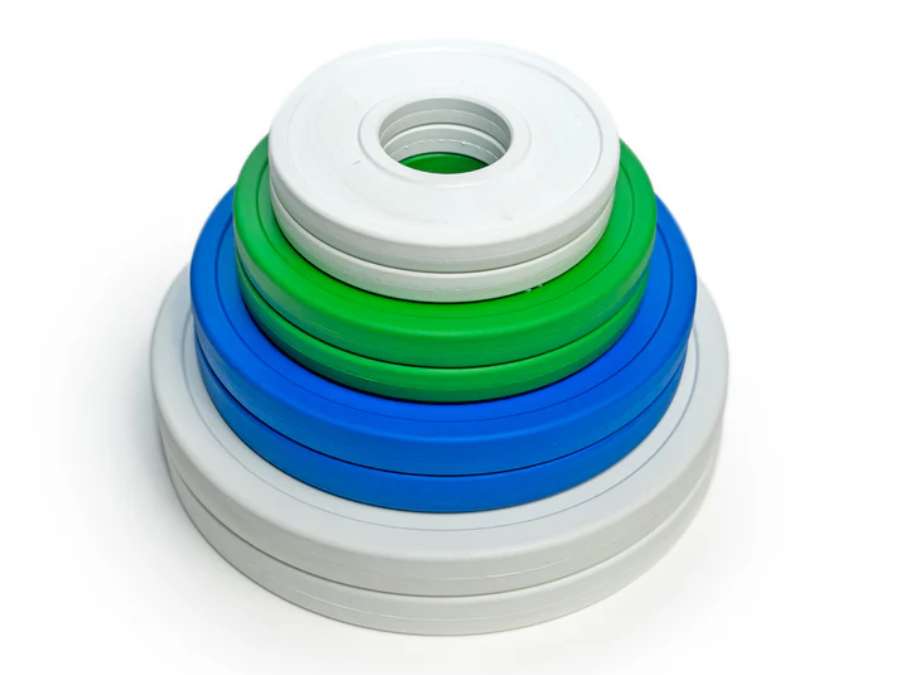
Fractional Plate
Fractional plates offer precise weight adjustments for fine-tuning lifts, can be added without removing the collar, and are designed to stay in place without touching the ground. Here are some of its characteristics:
- Micro Load Adjustment: Fractional plates allow for very small weight adjustments, ranging from 0.25 lb to 1 lb or 0.125 kg to 1 kg, ideal for precise loading.
- Compatibility: They can be used with change plates and added to the bar without removing the collar, providing stability.
- Material and Use: Typically made of iron or rubber-coated, fractional plates do not touch the ground during use and are suitable for precise loading in competition settings.
Tip:
For IWF or IPF Competitive Weightlifters: Use fractional plates for precise weight adjustments and exact increments in training and competition.
For Non-Competitors: Use fractional plates for gradual weight adjustments and precise load changes in workouts.
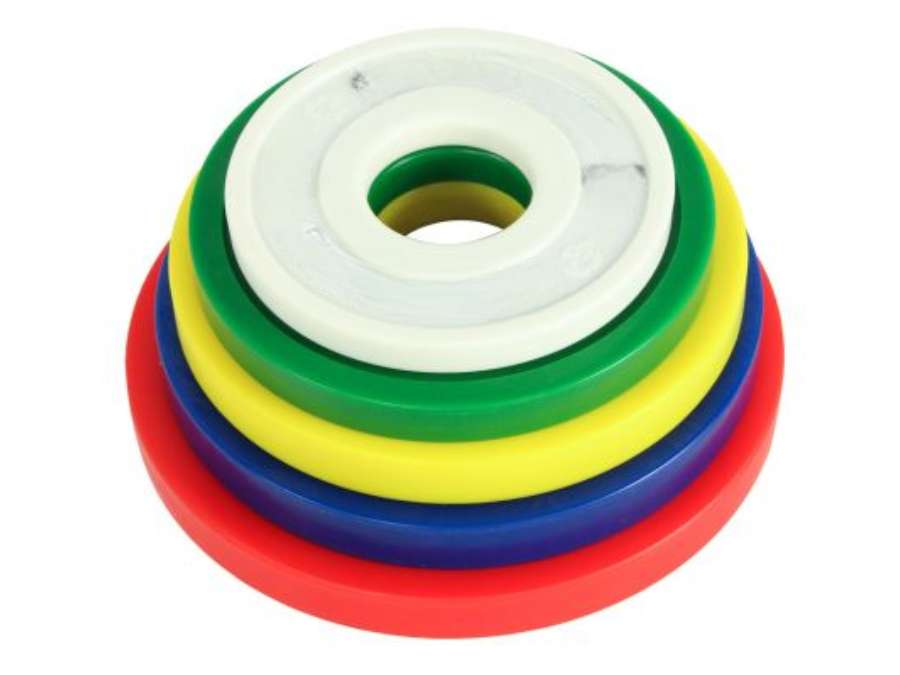
Types by Material
Bumper plates are typically constructed from rubber, whereas weight plates are often made from cast iron or other metals with possible rubber coatings. Here are the most common materials for bumper plates:
Virgin Rubber
Virgin rubber plates, often made in China, have a dense, thin design that delivers durability and minimizes bounce. Their smooth surface and vulcanized construction enhance wear resistance, making them suitable for heavy gym use.
Key Benefits:
- Enhanced Durability: Virgin rubber plates are wear-resistant and reinforced for heavy gym use.
- Reduced Bounce: Their dense, thin design minimizes bounce, enhancing safety.
- Low Odor: Free from adhesives, these plates emit a milder smell, ideal for odor-sensitive users.
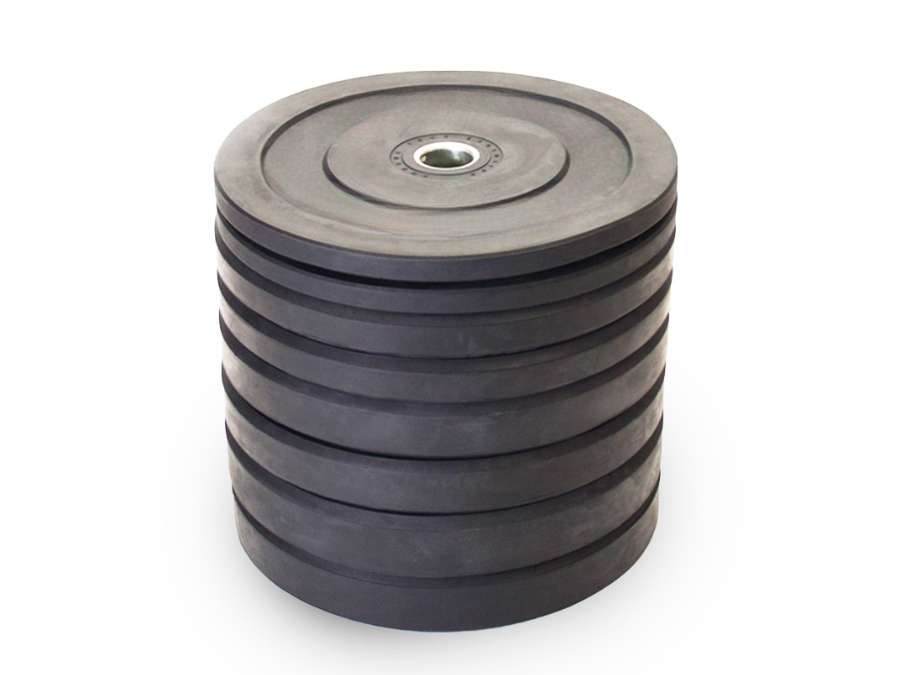
Crumb / Recycled Rubber
Crumb rubber plates, made from recycled tires or waste rubber, are cheaper and softer, with higher bounce and lower density compared to virgin rubber. Adhesive quality affects their durability and odor, with better adhesives leading to increased durability and less odor.
Crumb rubber plates may deteriorate over time, and their wider design limits the number that can fit on a bar. Hi-Temp plates from Tuscumbia, Alabama, use durable recycled vulcanized rubber and a 2-inch stainless steel insert but may have minor aesthetic flaws.
Key Benefits:
- Impact Absorption: Better than virgin rubber plates due to lower density.
- Less Cost: Offers similar functionality to virgin rubber plates at a lower price.
- Environmentally Friendly: Made from recycled rubber, aligning with environmental protection standards.
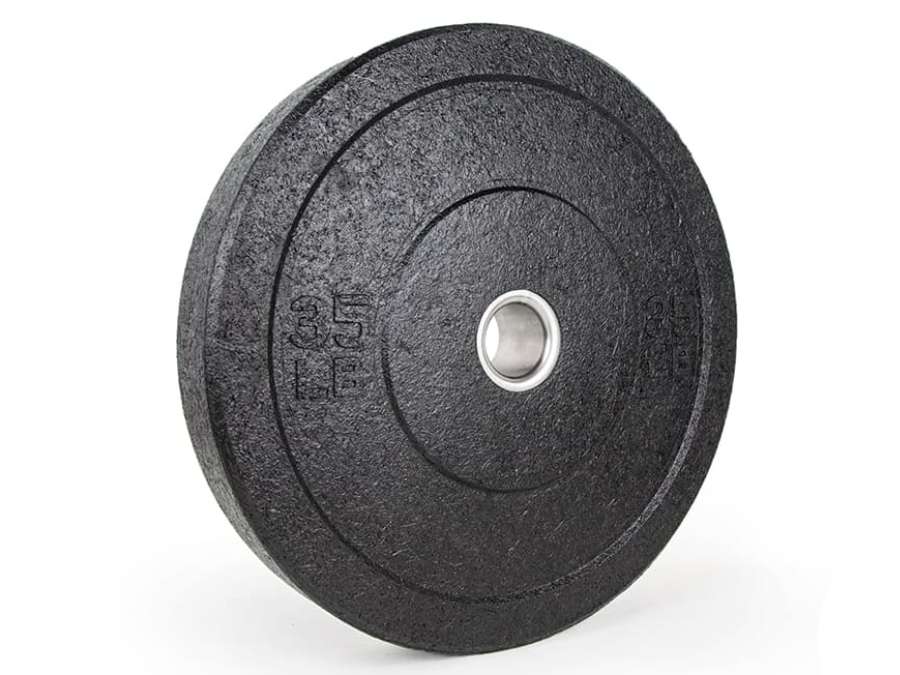
Urethane
Urethane, a synthetic compound blending the properties of plastics and rubber, provides bumper plates with exceptional durability and flexibility. This material allows for vibrant colors and offers extremely low bounce, making it a superior choice for those sensitive to odors and seeking long-lasting performance.
Key Benefits:
- Increased Longevity: Urethane plates are more resistant to wear, cuts, and tears compared to rubber plates.
- Increased Load Capacity: The thinner design of urethane plates allows for more plates on the barbell and improves load stability.
- Odorless: Urethane plates do not emit the strong “new tire” odor typical of rubber plates.
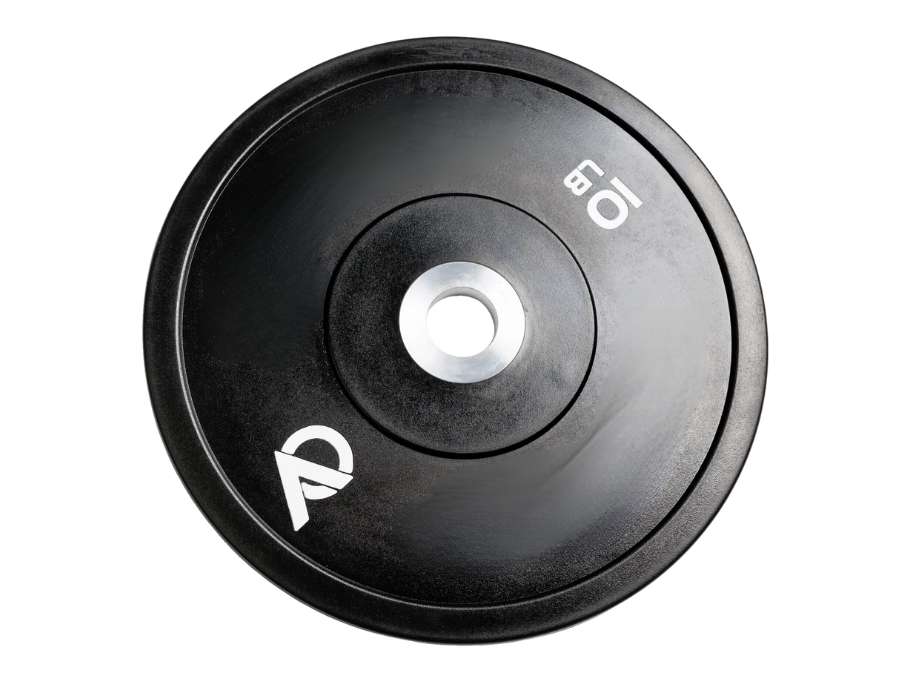
Knowing bumper plate types helps build a safer, better gym. YR Fitness makes plates for everything from daily training to competitions. Reach out here to find the perfect bumper plates for your facility.
3. Bumper Plate Physical Structure
The physical structure of bumper plates impacts both performance and durability. This involves understanding the design elements essential for selecting the most suitable plates for diverse training needs. Here are the key aspects and material options to consider:
Plate
Bumper plate quality is determined by the materials used. Urethane is the best option overall, followed by virgin rubber, and then recycled rubber, except for “hi-temp” rubber.
Steel Hub
The steel hub is crucial in bumper plates, with professional models often using galvanized or chrome-plated steel.
Most manufacturers now use stainless steel for hubs, with brass options increasingly avoided. This shift is reflected in the stainless steel market’s projected growth to USD 225.8 billion by 2032, highlighting its increasing use in gym equipment due to its durability, strength, and corrosion resistance, according to Market Research Future.
Steel hubs, made from steel 45, have a consistent diameter but vary in thickness with bumper sizes. They must fit securely into the bar’s sleeve to prevent sliding and provide easy use. These hubs enhance appearance, contribute 40-50% of the weight, and reduce bumper thickness, allowing more plates to be loaded on the barbell.
Strong construction keeps bumper plates safe and long-lasting. YR Fitness uses premium materials and precise engineering in every plate. Get in touch to explore our manufacturing standards for your gym.
4. Bumper Plate Physical Properties
Understanding the physical properties of bumper plates is crucial for selecting the optimal equipment for your gym. These factors influence performance, durability, and user satisfaction. Here are the key physical properties to consider when evaluating bumper plates:
Shape
Weight plates should be round to prevent movement. A lip on the edge makes it easier to pick up, especially when flat on the floor. Similarly, it extends the outer edge of the bumper, reducing collisions and protecting the steel hub. Here are the 3 primary shapes:
- Standard Circular: Provides stability and ease of use with a round shape and an edge lip for easy handling.
- Olympic Circular: Larger diameter plates designed for compatibility with Olympic bars, offering a stable and secure fit.
- Thinner or Slimline Circular: Reduced thickness allows more weight to be added while maintaining stability and ease of handling.
Weight
Bumper plates are offered in both kilograms and pounds, with a wider variety available in pounds compared to kilograms. If manufactured to IWF standards, each plate should be within ±10 grams of the claimed weight, as seen with YR Fitness plates. The majority of bumper plates on the market have a weight tolerance of 2-3%.
Bumper weights in pounds:
- 55 lb
- 45 lb
- 35 lb
- 25 lb
- 15 lb
- 10 lb
Bumper weights in kilograms:
- 25 kg
- 20 kg
- 15 kg
- 10 kg
Color
Bumper plates have a uniform diameter, which makes them hard to differentiate. They are color-coded according to IWF standards for quick weight identification and visual feedback. It turns out that adhering to these standards maintains consistency, with raised or molded lettering indicating weight. Plates deviating from these color codes should be avoided. The color codes are as follows:
- Red: 25 kg
- Blue: 20 kg
- Yellow: 15 kg
- Green: 10 kg
- White: 5 kg
Noise
Steel weight plates generate more noise than bumper plates. For example, the rubber or urethane in bumper plates absorbs impact, greatly reducing noise compared to the clang of steel plates. Here are specific noise characteristics of bumper plates:
- Quiet Noise: Rubber bumper plates absorb impact effectively, resulting in minimal noise.
- Average Noise: Urethane bumper plates offer moderate noise reduction while still providing durability.
- Loud Noise: Steel weight plates generate significant noise due to their harder material and lack of impact absorption.
Odors
Rubber products, including virgin and recycled rubber, can emit odors. Virgin rubber has a milder scent than recycled rubber, while urethane plates are odorless. Hi-temp rubber, though durable, has a strong odor and is better suited for commercial or garage gyms. For those sensitive to smells, sun exposure or soaking can help reduce odors, which will diminish over time with air exposure. Here are odors of bumper plates based on their materials:
- Milder Scent: Virgin rubber emits a milder odor compared to recycled rubber.
- Stronger Odor: Recycled rubber releases a stronger odor due to its material composition.
- Odorless: Urethane plates are odorless, providing a neutral scent.
- Strong Odor: Hi-temp rubber has a strong odor and is better suited for commercial or garage gyms.
Bounce and Hardness
Bumper plates are engineered to achieve a “dead bounce,” where they fall and stay put, requiring a high Shore hardness of 100. The Shore hardness scale measures material hardness, with higher numbers indicating greater resistance to indentation, though even high-quality plates may exhibit minimal bounce.
The point is selecting the right bumper plates involves balancing the trade-offs between bounce and noise based on specific requirements.
Bounce:
- High Bounce: Recycled rubber and hi-temp rubber exhibit high bounce due to their lower Shore A hardness ratings of 60 and 70, respectively.
- Moderate Bounce: Virgin rubber provides moderate bounce with a Shore A hardness rating of 85.
- Low Bounce: Urethane plates have low bounce due to their high Shore A hardness rating of 95.
Hardness:
- Soft: Recycled rubber is soft with a Shore A hardness rating of 60, leading to more bounce.
- Moderate: Virgin rubber offers moderate hardness with a Shore A rating of 85, balancing bounce and durability.
- Hard: Urethane and steel are hard materials with high Shore hardness, with Urethane at Shore A 95 and Steel at Shore D 60, resulting in minimal bounce.
Bend
Poor rubber quality and excessive fineness can lead to bending in bumper plates, especially in smaller or thinner plates that are more susceptible to damage. A bent plate creates an uneven load. Here are the list of bumper plates ranked by their tendency to bend:
- Increased Bend Tendency: Recycled rubber plates are more likely to bend due to lower quality and fineness.
- Intermediate Bend Tendency: Virgin rubber plates have a moderate tendency to bend, balancing quality and durability.
- Lesser Bend Tendency: Hi-temp rubber plates are less prone to bending, offering improved resistance.
- SlightBend Tendency: Urethane plates have minimal bend tendency due to their superior material quality.
Bounce, noise, and durability define bumper plate quality. YR Fitness crafts plates for quiet, reliable performance in busy gyms. Contact us now to see how our plates can elevate your training space.
5. Bumper Plate Accessories
Bumper plate accessories are essential for improving the functionality and longevity of gym equipment by securing, storing, and protecting both the weights and the gym environment. Let me elaborate on the most important accessories to consider:
- Collars: Secure bumper plates to the barbell to prevent shifting during exercises and enhance safety.
- Barbell Racks: Provide organized storage for barbells and bumper plates while reducing gym clutter and improving accessibility.
- Weight Storage Trees: Facilitate efficient storage and retrieval of bumper plates to maintain an orderly workout space.
- Plate Protectors: Shield floors and bumper plates from damage caused by dropped weights which extends their lifespan.
- Rubber Mats: Protect the floor and minimize noise from impacts to create a quieter and safer workout environment.
Accessories protect your investment and keep gyms organized. YR Fitness supplies storage, collars, and mats for bumper plate care. Talk to us for solutions that complement your equipment lineup.
6. Buying Tips and Traps to Avoid
Selecting the right bumper plates involves more than just considering brand and price. Understanding key factors can help avoid common pitfalls and make a sound investment for your gym. Here’s how to avoid common pitfalls and make the best choices when selecting bumper plates:
- Material Quality: Choose bumper plates made from high-quality urethane or solid rubber with durable iron cores. Avoid those made from impure urethane, inferior recycled rubber like shoe rubber, or those with substandard iron cores used to cut costs.
- Weight Accuracy: Choose plates with weight variances no greater than +/- 3% from their stated weight to provide accuracy.
- Warranty Coverage: Opt for bumper plates that come with at least a one-year warranty to make sure quality and durability.
- Dimensions: Verify that plates are approximately 450 mm in diameter and have a collar opening close to 50.4 mm to meet IWF standards.
- Color Coding: Confirm that the weight and color match the IWF standard and that the coloring is consistent for clarity and standardization.
- Lettering Type: Select plates with raised lettering instead of printed ones for greater durability and resistance to fading.
- Steel Hub: Prefer plates with steel or stainless steel hubs and consider chrome or zinc plating for added durability and finish.
- Drop Test: Review the number of drops the plate can withstand, as reputable manufacturers will provide this information. For example, YR Fitness drop tests from a height of 2.2 meters guarantee 30,000 uses for hi-temp bumpers, 20,000 uses for competition bumpers, and 10,000 uses for training bumpers.
Here is a detailed table summarizing key criteria to consider when selecting bumper plates for weightlifting:
Criteria | Specification | Reason for Importance |
Weight Accuracy | +/- 3% from the stated weight | Ensures accurate weight for proper training consistency. |
Warranty Coverage | At least one-year warranty | Provides assurance of quality and durability. |
Dimensions | 450 mm in diameter, collar opening close to 50.4 mm | Meets International Weightlifting Federation (IWF) standards. |
Color Coding | Match the IWF standard; consistent coloring | Facilitates easy identification and standardization. |
Lettering Type | Raised lettering | Enhances durability and resists fading. |
Steel Hub | Steel or stainless steel; chrome or zinc plating recommended | Improves durability and finish. |
Drop Test | Number of drops stated by the manufacturer, e.g., 30,000 for hi-temp, 20,000 for competition plates | Indicates the robustness and longevity of the plates. |
Choosing bumper plates wisely saves money and headaches later. YR Fitness builds precision-tested plates for lasting performance. Click here for expert guidance on selecting the right plates for your gym.
Conclusion
Selecting the right bumper plates is essential for optimizing your gym’s performance and extending equipment lifespan. A thorough understanding of types, properties, and key factors will help you make an informed decision.
We hope this guide has clarified your selection process for bumper plates. If you’re looking for premium gym equipment, YR Fitness provides top-tier, professional-grade options. Contact us today to learn more!
Dive Deeper Into Our Resources
Looking for more diverse product options? Browse through our handpicked selections:
For some insightful reads, we’ve curated a list of recommended articles just for you:
Still haven’t found what you’re looking for? Don’t hesitate to contact us. We’re available around the clock to assist you.
Related articles:
